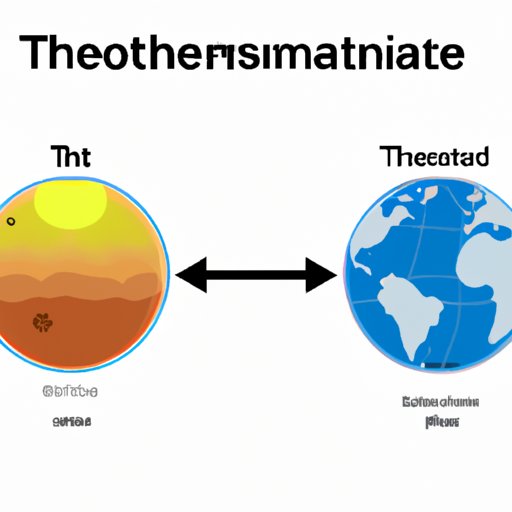Introduction
Have you ever wondered which layer of the Earth’s atmosphere is the hottest? It may not be the one that first comes to mind. While most of us might assume that the layer closest to the sun– the thermosphere– is the hottest due to its proximity to our star, the truth is a bit more complex. Understanding the science behind Earth’s hottest atmospheric layer is important because it can affect satellite communications, space travel, and even our planet’s climate. In this article, we will dive into the fascinating world of the thermosphere and uncover the surprising truth about the hottest layer of the atmosphere.
The Surprising Truth About the Hottest Layer of the Atmosphere: Understanding the Science Behind the Thermosphere
The thermosphere is situated in the outermost region of the Earth’s atmosphere, approximately 80km above the Earth’s surface. Due to its location, it is also referred to as the upper atmosphere, spanning from the mesosphere to the exosphere. It may not be the closest layer to the sun, but it is the layer most directly exposed to the sun’s radiation.
The thermosphere is known for its extremely low pressure, with its density decreasing exponentially with increasing altitude. This unique characteristic allows for the transmission of radio signals over long distances and provides opportunities for studying space.
Temperature is a crucial aspect of the thermosphere, and its high temperatures make it the hottest layer of the atmosphere. However, the temperature of the thermosphere is not measured in the traditional sense. Instead, it is measured by the kinetic energy of free-flowing gas molecules. Despite its high temperature, it would not be detectable by human touch as the gas molecules are not dense enough to pass on their heat energy.
Exploring the Mysteries of the Thermosphere: The Hottest Layer of the Earth’s Atmosphere
The high temperatures of the thermosphere are affected by various factors, including the sun’s radiation, geomagnetic activity, and the composition of the Earth’s atmosphere. Solar radiation is one of the most significant contributors to the temperature of the thermosphere; the thermosphere absorbs solar radiation, causing the gas molecules to move faster and build up heat energy. Hence, the thermosphere’s heating is directly related to the solar cycle.
Geomagnetic activity can also lead to an increase in temperature in the thermosphere. During geomagnetic storms, the Earth’s magnetic field interacts with charged particles from the sun, causing them to ionize and heat up the thermosphere. Strong auroras are associated with these geomagnetic storms.
There are considerable variations in temperature within the thermosphere. During the day, the thermosphere temperature can rise over 1000 degrees Celsius, while during the night, it can drop to below -100 degrees Celsius. These changes are due to fluctuations in the sun’s radiation, as well as the heating and cooling of individual gas atoms.
Baking in the Extreme Heat: The Thermosphere’s Record-Breaking Temperatures
The thermosphere’s temperature range is enormous, compared to other layers of the atmosphere. The thermosphere’s average temperature is about 1200 degrees Celsius, while the Earth’s surface has an average temperature of approximately 15 degrees Celsius. The minimum temperature of the thermosphere is around -100 degrees Celsius, and the maximum temperature can reach up to 3200 degrees Celsius.
These extreme temperatures have a significant impact on our planet’s climate. The high temperatures of the thermosphere cause an increase in air density, which creates atmospheric drag and slows satellites’ movement, leading to a shorter lifespan for artificial satellites. The thermosphere’s heat also causes the atmosphere to expand, potentially leading to space debris collisions.
The Secret World of the Thermosphere: Unlocking the Science Behind Its Hotness
Studying the thermosphere is challenging because it’s located at the edge of the Earth’s atmosphere and is too high to be accessed by traditional methods. Scientists must use remote sensing tools like satellites to gather data on the thermosphere. The data collected is used to create models to predict temperature and composition.
Models are used to simulate variations in temperature and how the atmosphere responds to geomagnetic activity and human activities. Studying the thermosphere has evolved, and recent studies have shown that airglow observations of the thermosphere are traceable to its meteoric origin, providing crucial information that assists in exploring climate variability over longer periods.
Why is the Thermosphere So Hot? Uncovering the Science Behind Earth’s Hottest Layer of the Atmosphere
The thermosphere’s heat is essential in maintaining the balance between the Earth’s radiation and the atmosphere. Environmental policies that ensure reducing the emission of greenhouse gases and control other pollutants are critical in reducing the possibility of a build-up of heat energy, which can result in an imbalance in the Earth’s energy budget. It is also essential to promote safe and responsible use of space to reduce the effects of atmospheric drag on space debris.
Conclusion
In conclusion, studying the hottest layer of the atmosphere is both exciting and a challenge in equal measure. The thermosphere, with its extreme temperatures and its effect on satellite equipment, climate, and space travel, continues to fascinate scientists, making it an area of active research and discovery. As we continue to learn more about the thermosphere, we can appreciate the complexities of the Earth’s climate and environment better.
